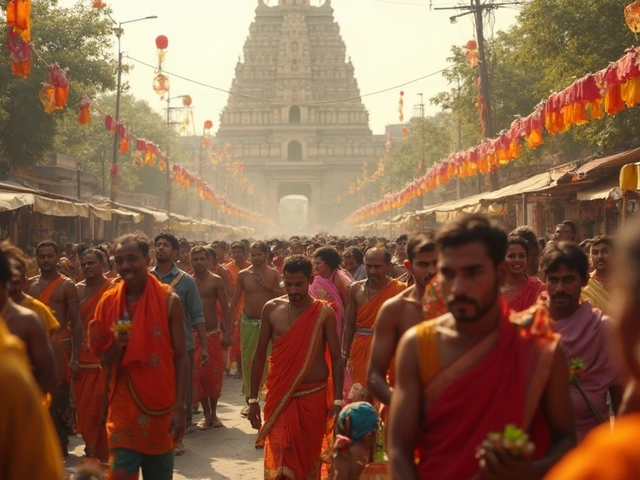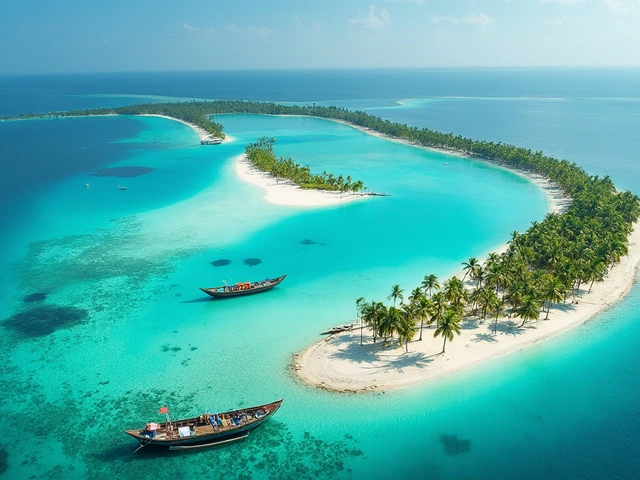Imagine standing in front of a 1,000-year-old stone temple, feeling the weight of history pressing through every carved surface. The air carries hints of spices, and prayers drift faintly from a nearby shrine. For most people, India is a riot of colors and sounds, but that's just scratching the surface. The national heritage of India is more than majestic palaces and grand festivals. It includes living traditions, languages older than Rome, groundbreaking science, and cities layered in centuries. Whether you’re a history buff, a food lover, or someone who just cares about deep roots, India’s heritage is the stuff of stories—and it's all right here in plain sight.
What Makes Up India's National Heritage?
India's national heritage isn’t just a fancy phrase for old things locked in glass cases—it’s alive, vibrant, and constantly evolving. Let’s get real for a minute: when we talk about India’s heritage, we’re talking about more than just its jaw-dropping forts and ancient ruins. It’s the art of block printing in Rajasthan, the classical music echoing through Chennai’s sabhas, the shadowy outlines of Ajanta’s Buddhist caves, and the scent of fresh dosas sizzling in a Tamil Nadu village street. All these things—tangible and intangible—come together to create what UNESCO calls a “priceless treasure.”
First off, India is home to 42 UNESCO World Heritage Sites as of 2025, including favorites like the Taj Mahal, Qutb Minar, and the Great Living Chola Temples. But it doesn’t stop at buildings. There’s the ancient Sanskrit epic, the Mahabharata, still recited by storytellers in rural towns. Then there’s yoga—yes, the same practice taking over gyms worldwide—which traces its roots back to the Indus Valley Civilization. Want an even wilder fact? India has more than 1,600 languages spoken across its states and territories. That linguistic richness is part of the national heritage too.
Don’t forget the natural wonders: the Western Ghats are a biological hotspot with more plant species than almost any other region in the world. They host tigers, king cobras, and thousands of endangered creatures. For just a taste of diversity, try listing out Indian festivals—it’s nearly impossible. There’s Diwali (the festival of lights), Eid, Vaisakhi, Pongal, Holi, Christmas, and dozens of local harvest festivals you may never have heard about. The food, the crafts, the bustling markets, even the philosophy—each of these threads together forms a tapestry that’s as old as time yet very much alive today.
Here’s a handy table that lays out just how varied India’s national heritage scene looks as of 2025:
| Heritage Type | Examples | No. of UNESCO Sites |
|---|---|---|
| Architectural Wonders | Taj Mahal, Qutb Minar, Red Fort | 29 |
| Natural Heritage | Western Ghats, Sundarbans, Kaziranga | 7 |
| Living Traditions | Yoga, Ayurveda, traditional dance forms | N/A |
| Intangible Heritage | Ramlila, Kumbh Mela, Vedic chanting | 6 |
India earns its reputation as a mix of past, present, and future. If you want to see how history blends seamlessly into modern life, this is the place.
Iconic Monuments and Ancient Architectural Marvels
If you’ve ever seen a photo of the Taj Mahal at sunrise, you know that architecture is a huge part of India's identity. Sure, the Taj is world-famous (and one of the New Seven Wonders), attracting millions of visitors a year—but it's just one chapter in a multi-volume story. India is packed with forts that whisper tales of conquest and betrayal, temples draped in myth and ritual, and palaces built for kings whose dynasties shaped entire regions.
The Qutb Minar in Delhi stands 73 meters tall and dates back to 1193, a time when Northern India was a battleground of empires. Move west to Rajasthan, and you get the towering Mehrangarh Fort jutting out over Jodhpur's blue city, standing since the mid-1400s. Down south, the Brihadeeswara Temple in Tamil Nadu is over 1,000 years old, an engineering marvel where the temple’s capstone alone weighs about 80 tons. How did they manage to place such a huge block atop a 66-meter-tall tower centuries ago? Some researchers believe they might have constructed a ramp almost a mile long and rolled it up using elephants. Not your usual building method.
Each state holds its own gems: the sun-splashed caves of Ajanta and Ellora in Maharashtra are full of Buddhist, Hindu, and Jain carvings—early proof of religious coexistence. The stepwells of Gujarat, like Rani ki Vav, are underground temples staring up at the sky, showing just how art and utility blend in Indian design. And then there are Mughal treasures like Fatehpur Sikri’s red sandstone palaces, built by Emperor Akbar.
But it’s not all stone and marble. There are wooden houses in Kerala called nalukettu, covered in intricate carvings, where generations still gather for Onam celebrations. Take a walk through Kolkata, and you'll spot colonial mansions next to Bengali terracotta temples. The layering of styles—Islamic arches, Hindu mandapas, Buddhist stupas, Portuguese forts—tells a story of invasion, synthesis, and local ingenuity. People love to say India is timeless. Maybe that’s because these buildings show us every layer of time at once.
“India’s monuments are not merely relics of the past; they are living records that witness centuries of societal change and aspiration.” — Romila Thapar, historian
Cultural Heritage: Diversity in Living Traditions
Now we’re into the good stuff—the stuff that moves, dances, cooks, and sings. The true magic of India’s heritage is that it’s not static or locked away in a museum. Think of Bharatanatyam dancers balancing on the tips of their toes in a Chennai auditorium, or a Lucknowi chef mastering the hundred-year-old technique for perfect galouti kebabs. These are living traditions, passed down family to family, often without skipping a beat.
Start with performing arts. India has more than eight officially recognized classical dance forms, from the dramatic Kathakali in Kerala to the fluid Odissi of Odisha. There’s an entire subcontinent of folk songs, shadow puppetry, and masked theater—just check out the Manipur Raas Leela for a visual treat. You’ll also find classical music traditions dating back to 1500 BCE, like Hindustani and Carnatic, that are still performed with utmost devotion both onstage and at home. And get this: every part of India has its own style of painting, from the bold Warli drawings of Maharashtra to the rainbow-bright Madhubani art of Bihar.
Food is another huge part of the mix. The cooking style changes every 200 kilometers—sometimes radically. Try Punjabi butter chicken in Amritsar, fiery Chettinad curries in Tamil Nadu, cloud-like idlis in Karnataka, or Parsi dhansak in Mumbai. Even street food varies wildly—gavvalu sweets in Andhra Pradesh don’t taste anything like the pani puri carts of Kolkata. If you want a culinary heritage tip, ask locals for recommendations. The best tastes are found in roadside stalls, busy markets, or old-school home kitchens.
Festivals are the real show. Whether it’s Holi—where streets turn into rainbows of colored powder—or Pushkar Camel Fair with its thousands of humped visitors, Indian festivals are loud, heartfelt, and completely unique. Take Kumbh Mela, for instance, which draws over 50 million people in a single massive congregation, making it one of the world’s largest peaceful gatherings. Each festival has its own set of traditions, sweets, music, and rituals tied to the changing seasons, local legends, and community pride.
Textiles are another massive chapter. The world’s oldest cotton textiles come from the Indus Valley. India still dazzles with Banarasi silks, Kanchipuram sarees, phulkari embroidery from Punjab, and block-printed fabrics from Jaipur. Each one tells its own story, shaped by folk traditions and the creativity of generations.
Don’t underestimate the intangible stuff either—proverbs, parenting customs, and traditional games like kabaddi and gilli-danda are all part of what makes up India’s cultural DNA. The law of hospitality—"Atithi Devo Bhava" (Guest is God)—is still alive. Walk into a village home and see how quickly you’re offered tea and snacks, no matter how busy the day.
Preserving and Experiencing India's National Heritage Today
It’s easy to think that heritage is something fragile—delicate pottery or faded manuscripts in a museum. But in India, the real challenge is in protecting heritage while keeping it living and open for everyone, including you, the traveler or curious armchair explorer.
Ever since Independence, the government and local communities have stepped up with laws and creative programs to protect ancient temples and monuments. The Archaeological Survey of India operates as the main guardian, but local NGOs and volunteers play a huge part too. Some villages in Rajasthan, for instance, have pooled funds to restore stepwells and old havelis. In Maharashtra, community-run museums showcase local crafts and village histories. There’s even a project in Varanasi that’s digitizing ancient Sanskrit manuscripts from riverbank libraries, making them available for the world.
But it’s not just about preservation—it’s about keeping things vital and meaningful. Many young Indians are rediscovering embroidery, pottery, and traditional arts. Digital platforms like Instagram and YouTube are full of local chefs sharing age-old recipes or young artists teaching regional dance steps. Travelers can sign up for block-printing workshops, stay in heritage hotels (often former palaces), or join food trails through old city markets. If you’re planning a trip, it pays to go beyond the big-name sights—a day spent at a local fair or a village crafts cooperative will probably reveal more about the real India.
If you’re worried about overtourism or the wear-and-tear on famous sites, there are ways to be a responsible traveler. Always hire licensed local guides when visiting heritage areas. Respect sanctity in temples and mosques—cover up, take off shoes, and follow posted signs. Many conservation organizations offer heritage walks, letting you tip directly to support restoration projects. Want souvenirs? Choose handmade, locally sourced craft items instead of mass-produced stuff.
Heritage in India isn’t an abstract concept—it’s woven into the day-to-day, in the flavors, songs, architecture, and warmth you experience just by being there. As the next generation dives into digital spaces, that same heritage moves right along with them. The best way to understand India’s national heritage? Immerse yourself. Taste the food, listen to the rhythms, sit beneath ancient arches, and let the stories whisper their secrets. There’s no other place quite like it, and probably never will be.


